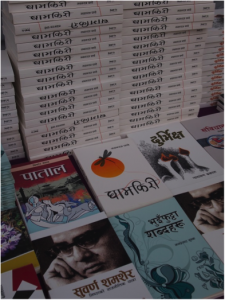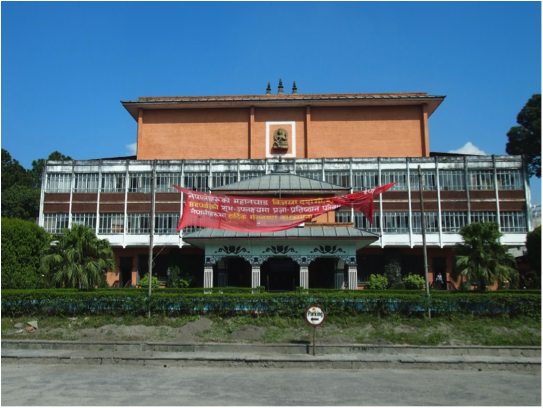Editor’s Note: Ever wonder what’s happening literature-wise in Kathmandu? Wonder no more, our editors in Nepal are here to fill you in, and it turns out, there’s no lack of corruption and infighting… This is part 1 of a 2-part dispatch.
The 2013 NCell Nepal Literature Festival started inauspiciously for us, as they say in this part of the world. Arriving at the Nepal Academy in central Kathmandu ten minutes early on the first day, Ross asked in Nepali where the opening ceremony was being held, and we were ushered upstairs into a packed auditorium, where there was a man already speaking. Strange, I thought, as we were early, and things do not generally start on time in Nepal. We clambered into some seats in the middle of a row. Ross began listening to the speaker. “He’s not talking about literature,” he informs me. “He’s talking about the truth.” It dawns on us that we might not be in the right place, so we hope things will wrap up soon and move on to the event we came for. Ross continues to listen. “Oh no, we’re in a Christian convention!” We clamber back out sheepishly, avoiding eye contact. Some better signage from the organisers of the literature festival would’ve been welcome!
The literature festival was actually being held in two outdoor, covered locations at the same venue. Under a marquee, Nepal’s rashtrakavi (national poet) Madhav Prasad Ghimire got the festival underway by shuffling through a speech on a life-journey through books and literature to an appreciative audience that spilled out into the gardens.

[Nepali-language books for sale at the Bookworm bookstore tent]
The Nepali sessions
Only two languages were represented in the programme: Nepali and English. One might think two languages are quite enough for one festival, but in a country where the census recognises 92 national languages (some of which have literary traditions older than Nepali’s), one might have expected at least a few of these to get a look at a festival billed as the ‘Nepal Literature Festival’.
But Nepali also has its own battle to fight in South Asia, where the English publishing sphere continues to draw larger and larger readerships and financial returns. According to Basanta Thapa, a member of the Translation Committee, only 15,064 books with ISBN numbers have been published since Nepali publishers adopted the ISBN coding system in January 2000 (3 million were published in the US in 2011).
Several speakers stressed the need for Nepalis to take into their own hands the way their country is seen by the rest of the world. The long-standing go-to images–60s and 70s hashish-enthused accounts of an isolated Himalayan kingdom of Sherpas, Buddhas, and rice paddies—needs an update. Nepal got rid of the monarchy in 2008 after a ten-year civil war; Kathmandu has long been a victim of its own unplanned growth, and recently a group of activists had to wage a campaign to bring Buddha back to Nepal after an Indian TV host made the mistake of stating that the Buddha was born in India. Development literature, which has largely replaced the hippy corpus of foreign writing on Nepal, is also extremely limited in its approach and hardly makes for enjoyable reading. It is high time Nepalis took over their public image production and management, the speakers reiterated with gusto.
The debate on promoting languages other than Nepali mirrors the ongoing arguments about federalism in the country. One question those at the National Academy may have to face is whether Nepal should be divided up into ten or more provinces (depending on which political party gets its way following this month’s elections), and what will be the impact of this fragmentation on the number of readers of Nepali, which, like the central state, will have to compete with many new actors for resources.
Discussed on the opening day was a publication that has recently gotten every part-time politico talking. Sudheer Sharma’s book Prayogshala (‘Laboratory’) is a study of the relationship between the Royal Palace, members of the Indian government and security services, and the Maoist leadership during the civil war. The book has received widespread publicity and generally favourable reviews, and has generated renewed scrutiny regarding how aware the political leadership in Nepal was that they were being manipulated by the Indian state, but complied anyway because of their own factional interests. The charge that Sharma withheld the materials used to research and write the book until publication have, however, led at least one commentator to wonder if this exposure hasn’t implicated Sharma and the press as well.
Few politicians have felt the need to deny the claims of Prayogshala. Complicity and behind-the-scenes horse trading are well-established in Nepali politics, and with everyone getting ready for elections, any serious questioning of the actions of the netas (leaders) is likely to be lost in the hubbub of the campaigns. Facing the brunt instead will likely be India, whose interference in Nepal’s politics constitutes one of the perennial fears of the Kathmandu intelligentsia, to which Prayogshala will no doubt contribute an enticing and profitable chapter.
A roundtable session titled ‘A Vision for a Translation Campaign’ discussed the future of translation, a topic pertinent to the literary scene here, which continues to suffer from a dearth of quality translators working into and out of Nepali. Each speaker spoke only once before taking questions, giving them little opportunity to make their position or recommendations clear, stifling the debate somewhat, which one felt was still waiting to really take place by the time the session finished. The talks opened by stressing the role Nepali literature had to play in the capturing of the national bhav (sense, gist, or essence) of Nepal and Nepalis, and the need for their writings to take control of the way Nepal portrays itself to the world.
Translating from foreign works is the solution to the national corpus shortage, opined translation committee member Basant Thapa, although this isn’t always easy: after all, there are many meanings in Nepali for ‘black tea’, he reminded everyone, while other cultures too have their own distinct bhav which can be hard to transmit. A rather esoteric monologue on Carl Jung and dream interpretation followed and then gave way to a brief aside on how computer programmes are playing increasing roles in translating technical works. And this was the limit to which the practicalities of a translation campaign were discussed – the panel seemed too preoccupied with the difficulties of the act (hardly specific to Nepali) and the current lack of established translators to come up with any concrete and positive steps.
Interestingly, there was no mention of translating Nepali into other languages, which was particularly surprising as the continued dominance of the ‘Shangri-La’ motif in representations of Nepal to rest of the world had already been mentioned as one of the major misconceptions that Nepalis need to overcome. Foreigners who can understand the Nepali used in literature are extremely few (I counted fewer than five at the Nepali discussions I attended). Surely translation into English, French, Spanish and Hindi should have been top of the agenda, especially when, as writer Shekhar Kharel told me, there exists a ready market in neighbouring countries for Nepali fiction in translation.
The NCell Festival is a reminder that more and more Nepalis are writing fiction that is grappling with the abundance of social and cultural changes happening in their society. Several have already achieved widespread acclaim for their writings in English; Manjushree Thapa, Samrat Upadhyay, and recently Prajwal Parajuly to name but a few, and in spite of the usual worries, Nepali-language fiction seems, at the moment, to be doing just fine. Mahesh Bikram Shah’s collection of short stories Chhapamarko Chhoro and Kumar Nagarkoti’s Fossil show new engagements with absurdist and fantastical themes (Nagarkoti has ‘deconstructed literature’s established assumptions’ according to one review), while the Maoist civil war and life in the diaspora have provided stimulants to the established realist tradition. With the netas and government continuing to be what they are, some good protest literature that is not simply a Maoist or Marxist diatribe is needed. Arguably the last mass popular figure to achieve this was the bohemian darling of both palace and people, poet Bhupi Sherchan, who died in 1990. In laying bare the ills and injustices of Nepali society, his terse, accessible, satirical poems have yet to find successors, unless one delves into the growing hip-hop and slam poetry scenes, though it may be a few years before such genres are seen in the gardens of the National Academy. And for the moment it seems apparent that in Nepal, Nepali remains the only language that can garner enough support to host a literary festival. (Maithili and Bhojpuri, spoken in parts of southern Nepal and in India, did receive some attention at the 2012 Jaipur festival in India.)
The organisers and writers of the festival were mainly high caste, and every audience I sat in was overwhelmingly made up of males over thirty-five. Some will undoubtedly take issue with this. But then, hopefully, most of the literature of tomorrow is being produced by those too cool or too mad for the festivals. If these can keep writing and translation campaigns can be successful, the rest of the world may begin to discover what Kathmandu already knows – that discovering Shangri-La doesn’t exist can be a good read.
(Part 2 of Kathmandu coming later this week!)
Elen Turner is Asymptote’s Editor-at-Large (Nepal) and reported on the English-language sessions. Ross Adkin is a writer and editor based in Kathmandu, and reported on the Nepali-language sessions.

